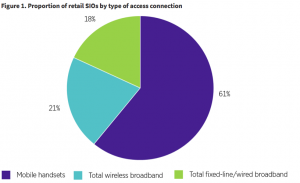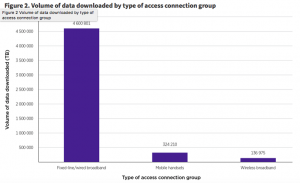New report tracks internet activity on mobile and fixed lines

Mobile handsets continue to be the most common way consumers are accessing the internet while the largest volume of data is downloaded over fixed lines, as shown in a new ACCC data report on internet activity.
The report, for the period ending 31 December 2018, also provides information on the number of retail services in operation (SIOs) by connection type and download speeds as well as the volume of data downloaded within Australia.
The total number of retail SIOs reached 39.9 million as at the end of last year; 24.3 million of these were mobile handsets, 8.4 million were wireless broadband and 7.2 million were fixed-line/wired broadband.
“This report provides a clear indication that while consumers are most often using their phones to access the internet, when downloading significant content they currently favour fixed line connections,” ACCC Commissioner Cristina Cifuentes said.
Proportion of retail SIOs by type of access connection

The greatest proportion of total fixed-line/wired connections are fibre connections (at 49 per cent) with DSL connections accounting for 34 per cent.
Fixed-line/wired technologies accounted for 91 per cent of the total volume of data downloaded. Mobile handsets and wireless broadband contributed significantly less to the total with proportions of 6 per cent and 3 per cent respectively.
“The volume of data downloaded is expected to grow exponentially as the result of the increased usage of content streaming services such as Netflix, social media such as Facebook, and applications including online gaming that continue to incorporate content-rich and video components,” Ms Cifuentes added.
Volume of data downloaded by type of access connection group

“The most popular speed tier for fixed line and wireless broadband SIOs (excluding mobile handset) is less than 24 megabits per second,” Ms Cifuentes said.
The speed tier of less than 24 megabits per second (Mbps) accounted for 61 per cent of all fixed-line/wired and wireless broadband SIOs (excluding mobile handset), followed by the 24 Mbps to less than 50 Mbps (25 per cent), 50 Mbps to less than 100 Mbps (8 per cent) and
100 Mbps or greater (5 per cent).








